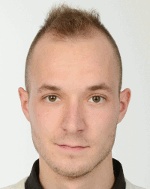 |
|
Biography
Vito Simonka was born in Murska Sobota, Slovenia, in 1991. He holds a bachelor's and master's degree in Physics from the University of Maribor, Slovenia. He joined the Institute for Microelectronics in August 2015 as a research assistent. His scientific interests include computational modeling for process TCAD, in particular SiC oxidation.
Modeling of Silicon Carbide Dopant Activation During Post-Implantation Annealing
Silicon-based (Si) power electronics have several limitations for high voltage, temperature and frequency applications. Wide band gap semiconductors, in particular silicon carbide (SiC), are especially suited to replacing traditional Si in order to increase device switching frequencies, block voltages and current densities. The fabrication steps for devices including SiC have not been fully optimized, even though the semiconductor industry understandably needs to decrease its operation and production costs. The most-used technology for selective doping is currently ion implantation, which requires a post-implantation annealing treatment in order to repair crystal defects and increase the electrical activation of dopants, as shown in Fig. 1. Modeling and simulation techniques used for the study of dopant activation in SiC are currently in an immature state. We have therefore performed a comprehensive study of the dopant-specific annealing steps and introduced a novel model, which has been empirically evaluated according to experimental data. Obtained parameters were implemented into Silvaco's Victory Process simulator.
The model was evaluated via strict comparison between simulations (solid lines) and experiments (symbols), as seen in Fig. 2. The simulation setup consisted of a nitrogen-doped, n-type SiC wafer with a compensation concentration of ≅ 5 ∗ 1015 cm-3, followed by several Al-implantations generating a rectangular profile with a mean concentration of ≅ 1 ∗ 1017 cm-3. The annealing steps were 12 hours at TA=1300∘C, 1 hour at TA=1400∘C and 10 minutes at TA=1500∘C. Note, the time of the thermal treatment influences the diffusion but does not enter the proposed activation model. The acceptor profiles were reproduced with an average variation of less than 3% in all of the annealing steps for both p-type dopants. The accurate reproduction of both implantation profiles and acceptor concentrations requires our modeling approach within the simulator to correctly predict the electrical characteristics of SiC devices. In addition to verification by comparison with experimental data, we have performed various simulations to predict the minimum temperature required for the full activation of the implants, which was achieved for the thermal treatments above TA=1700∘C.

Fig. 1: A schematic representation of the interstitial and substitutional impurities after implantation and annealing, respectively.

Fig. 2: Depth profiles of implanted dopant and annealed acceptor concentrations of Al-doped SiC. Open symbols refer to the implanted profiles, colored symbols refer to the experimental data of average concentrations from experiments, and solid lines refer to the reproduced and predicted results obtained in our study. The simulations were performed with the Victory Process simulator using Monte Carlo implantation, the Fermi diffusion model and the activation model from our study.



